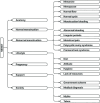Menstrual Health Education Using a Specialized Large Language Model in India: Development and Evaluation Study of MenstLLaMA
- PMID: 40669074
- PMCID: PMC12286563
- DOI: 10.2196/71977
Menstrual Health Education Using a Specialized Large Language Model in India: Development and Evaluation Study of MenstLLaMA
Abstract
Background: The quality and accessibility of menstrual health education (MHE) in low- and middle-income countries, including India, remain inadequate due to persistent challenges (eg, poverty, social stigma, and gender inequality). While community-driven initiatives have sought to raise awareness, artificial intelligence offers a scalable and efficient solution for disseminating accurate information. However, existing general-purpose large language models (LLMs) are often ill-suited for this task, tending to exhibit low accuracy, cultural insensitivity, and overly complex responses. To address these limitations, we developed MenstLLaMA-a specialized LLM tailored to the Indian context and designed to deliver MHE empathetically, supportively, and accessibly.
Objective: We aimed to develop and evaluate MenstLLaMA-a specialized LLM tailored to deliver accurate, culturally sensitive MHE-and assess its effectiveness in comparison to existing general-purpose models.
Methods: We curated MENST-a novel, domain-specific dataset comprising 23,820 question-answer pairs aggregated from medical websites, government portals, and health education resources. This dataset was systematically annotated with metadata capturing age groups, regions, topics, and sociocultural contexts. MenstLLaMA was developed by fine-tuning Meta-LLaMA-3-8B-Instruct, using parameter-efficient fine-tuning with low-rank adaptation to achieve domain alignment while minimizing computational overhead. We benchmarked MenstLLaMA against 9 state-of-the-art general-purpose LLMs, including GPT-4o, Claude-3, Gemini 1.5 Pro, and Mistral. The evaluation followed a multilayered framework: (1) automatic evaluation using standard natural language processing metrics (BLEU [Bilingual Evaluation Understudy], METEOR [Metric for Evaluation of Translation with Explicit Ordering], ROUGE-L [Recall-Oriented Understudy for Gisting Evaluation-Longest Common Subsequence], and BERTScore [Bidirectional Encoder Representations from Transformers Score]); (2) evaluation by clinical experts (N=18), who rated 200 expert-curated queries for accuracy and appropriateness; (3) medical practitioner interaction through the ISHA (Intelligent System for Menstrual Health Assistance) interactive chatbot, assessing qualitative dimensions (eg, relevance, understandability, preciseness, correctness, and context sensitivity); and (4) a user study with volunteer participants (N=200), who evaluated MenstLLaMA in 15- to 20-minute randomized sessions, rating the system across 7 qualitative user satisfaction metrics.
Results: MenstLLaMA achieved the highest scores in BLEU (0.059) and BERTScore (0.911), outperforming GPT-4o (BLEU: 0.052, BERTScore: 0.896) and Claude-3 (BERTScore: 0.888). Clinical experts preferred MenstLLaMA's responses over gold-standard answers in several culturally sensitive cases. In medical practitioners' evaluations using the ISHA-the chat interface powered by MenstLLaMA-the model scored 3.5 in relevance, 3.6 in understandability, 3.1/5 in preciseness, 3.5/5 in correctness, and 4.0/5 in context sensitivity. User evaluations indicated even stronger results, with ratings of 4.7/5 for understandability, 4.3/5 for relevance, 4.28/5 for preciseness, 4.1/5 for correctness, 4.6/5 for tone, 4.2/5 for flow, and 3.9/5 for context sensitivity.
Conclusions: MenstLLaMA demonstrates exceptional accuracy, empathy, and user satisfaction within the domain of MHE, bridging critical gaps left by general-purpose LLMs. Its potential for integration into broader health education platforms positions it as a transformative tool for menstrual well-being. Future research could explore its long-term impact on public perception and menstrual hygiene practices, while expanding demographic representation, enhancing context sensitivity, and integrating multimodal and voice-based interactions to improve accessibility across diverse user groups.
Keywords: artificial intelligence; cultural sensitivity; digital health; health equity; large language model; menstrual health education.
© Prottay Kumar Adhikary, Isha Motiyani, Gayatri Oke, Maithili Joshi, Kanupriya Pathak, Salam Michael Singh, Tanmoy Chakraborty. Originally published in the Journal of Medical Internet Research (https://www.jmir.org).
Conflict of interest statement
Figures





Similar articles
-
Large Language Models and Empathy: Systematic Review.J Med Internet Res. 2024 Dec 11;26:e52597. doi: 10.2196/52597. J Med Internet Res. 2024. PMID: 39661968 Free PMC article.
-
A dataset and benchmark for hospital course summarization with adapted large language models.J Am Med Inform Assoc. 2025 Mar 1;32(3):470-479. doi: 10.1093/jamia/ocae312. J Am Med Inform Assoc. 2025. PMID: 39786555
-
Ophthalmological Question Answering and Reasoning Using OpenAI o1 vs Other Large Language Models.JAMA Ophthalmol. 2025 Jul 31:e252413. doi: 10.1001/jamaophthalmol.2025.2413. Online ahead of print. JAMA Ophthalmol. 2025. PMID: 40742581
-
Development and Validation of a Large Language Model-Powered Chatbot for Neurosurgery: Mixed Methods Study on Enhancing Perioperative Patient Education.J Med Internet Res. 2025 Jul 15;27:e74299. doi: 10.2196/74299. J Med Internet Res. 2025. PMID: 40663377 Free PMC article.
-
Participation in environmental enhancement and conservation activities for health and well-being in adults: a review of quantitative and qualitative evidence.Cochrane Database Syst Rev. 2016 May 21;2016(5):CD010351. doi: 10.1002/14651858.CD010351.pub2. Cochrane Database Syst Rev. 2016. PMID: 27207731 Free PMC article.
References
-
- Tuli A, Dalvi S, Kumar N, Singh P. "It’s a girl thing": examining challenges and opportunities around menstrual health education in India. ACM Trans Comput-Hum Interact. 2019 Jul 25;26(5):1–24. doi: 10.1145/3325282. doi. - DOI
-
- Bhartiya A. Menstruation, religion and society. IJSSH. 2013:523–527. doi: 10.7763/IJSSH.2013.V3.296. doi. - DOI
MeSH terms
LinkOut - more resources
Full Text Sources
Medical

